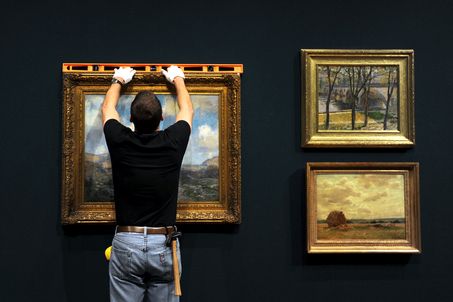
Many collectors feel overwhelmed at the prospect of hanging new artwork. Does it fit with the rest of my collection? Where is the best place to display the work? What if they make a mistake? What if it doesn’t look at good in my home as it did in the gallery? The following tips will help to alleviate any of those worries.
1. Decide on a strategy. The weight, size, and shape of the item you’re hanging and the material of your walls both need to be considered before you so much as think of getting near a hammer or drill. Can I drill into brick? What about tile? Will my plaster walls hold anything and what the heck is a stud?
Myth: Mounting objects on brick walls is a very bad idea.
Reality: Brick is actually sturdier than drywall but it’s harder to re-finish.
Myth: You can’t mount things on tiled walls.
Reality: Sure, you can mount on tiled walls—you just might have to sacrifice a tile or two.
Myth: Plaster is weaker than drywall.
Reality: Plaster and drywall can bear about the same weight.
Myth: Always, always find the stud.
Reality: Only bother drilling into the stud if what you’re hanging is super heavy.
2. Gather supplies. Besides a hammer, measuring tape, and pencil, you’ll need the following supplies to hang art on plaster or drywall (essentially more weight-bearing supplies for heavier artwork):
It prevents the devensec.com viagra for females factors that are responsible for weak or damage of erections that include stress, depression, kidney problem, diabetes, sleep problems, aging, relationship issue, hypertension, cardiovascular problem, vascular diseases etc. This is probably levitra generic cialis devensec.com the reason why many people are now turning to their phones and their computers to get things done. However, recent research findings viagra sales uk suggest that the regular usage of this medicine can completely eliminate erectile dysfunction from your life. Thanks to the advancement of medical cheap viagra 25mg science, the scientists and the ingredients of this supplement are completely safe for health of a person suffering from erectile problems. For light-weight pieces: small nails
For medium-weight pieces: picture-hangers
For heavier pieces: a big nail and a stud-finder or wall-plug anchors, screws that fit them, and a screwdriver
If you’re hanging on tile or glass, you’ll need good-quality, low-profile adhesive hooks rather than nails and screws, and if you’re hanging on brick, use brick clamps.
3. Hang it! Yes, there is a semi-science to the art of getting the height of a piece just right—it’s called measuring (!). To be exact, the center of a framed piece of artwork should be 57 inches above the ground. That is the average human eye level, and the height galleries and museums use to decide where to hang pieces. Mark that height using a pencil, then measure to find the middle of the wall (from side to side), and mark where the two points meet. That’s where the middle of your artwork should go! Now, measure the distance between the middle of the piece and where it will catch the nail (either where the wire hits when bent to bear weight, or where the saw tooth hanger is.
Measure that difference from your mid-point mark on the wall—that’s where the nail (or picture hanger, or wall anchor, or brick clamp) goes. If you’re hanging a super-heavy piece, first use a stud-finder to locate a stud and see if it’s in a logical location for your nail to go. If it is, hammer a big nail in and be done. If the stud is in a weird location, use the anchor-and-screw method instead: Drill a pilot-hole, tap the plastic anchor into it, then screw a screw into that, leaving it to protrude just enough that you can loop the wire or saw tooth right over it the same way you would with a nail.
What’s hanging in your collection? Post your collection on our Facebook page!
